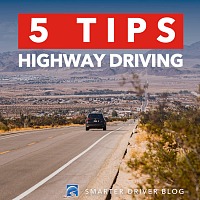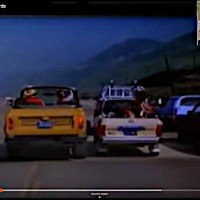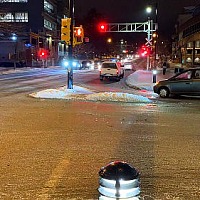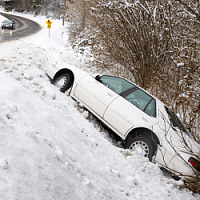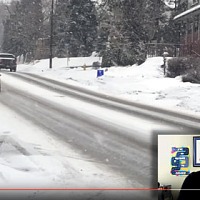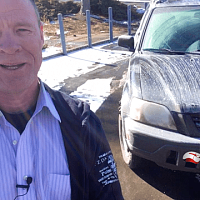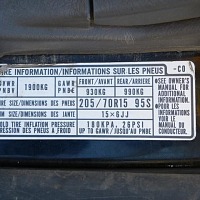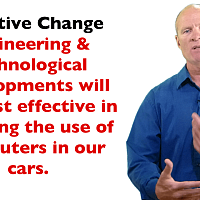Driver's with disabilities can drive! Learn how here.
Car Modifications for Drivers with Disabilities
https://www.youtube.com/watch?v=xTxFuaPTKeY&list=PL0x-bChcUvwHbwYzoI2427a_ORXJNwayK&index=1
#smartdrivetest #southtraildrivingschool #driverswithdisabilities #drivingwithhandcontrols
Closed Caption
- He wheels into the van. We get the chair around, the driver's seat chair around and he just reaches underneath the wheelchair, pulls out his catheter bag and throws it onto my seat. I was like, oh, I really hope that doesn't break. I really hope that doesn't break. It's important that we talk about drivers with disabilities or people that have disabilities who are learning how to drive with hand controls and those types of things. And I did a lot of that while I was working at Parkwood Hospital in London, Ontario, while I was finishing up my undergraduate degree. I also did some CDL work, drivers, truck drivers and bus drivers. So we only worked with paraplegics. They had full control of their upper extremities. And the van, they could wheel into the van and then transfer because the seat, the driver's seat turned 90 degrees. They could transfer into the driver's seat, and then drive the van with hand controls. Hand controls are really easy to drive. I mean, the car was incredibly easy to drive. It was simply a handle on this side, that controlled the throttle and the brake. And you just pulled back on the lever to throttle up. It was an automatic car. And then to apply the brake, you just pushed the whole assembly forward, which, you know, as you're breaking the vehicle is slowing down, it's causing you to move forward anyway. So it assist with the breaking, and makes it fairly simple. Both the car and the van also had a spinner knob because obviously they're only driving with one hand, people with disabilities. Most people who are paraplegics did have difficulty for the first one or two, maybe even three lessons. For people who are driving vehicles with hand controls, and most of these people had driven before. So we were simply retraining them to drive with hand controls. And the biggest thing was to teach them fine motor control, which they had learned with their legs previously when they were driving a car. Now we're teaching them fine motor control to operate the throttle and the brake with their hands. So that was a fairly big transition. Carrie, have you ever worked with anyone with high functioning autism or Asperger's syndrome, to help them with driving skills? I have worked with people, learning disabilities and those types of things, for those types of people Carrie, there's a lot of focus on the fundamentals. I taught my sister in law for example, to drive, and she had a learning disability. She had a lot of trouble with it. And with her, it was not very much driving on the road. I had to focus a lot on slow speed maneuvers, backing down an alley, going to the parking lot, forward figure eights, reverse figure eights, slow speed maneuvers, backing into parking spaces. And we spent a lot of time doing that. More than most people would, probably three times as much. And people who have those kinds of high functioning autism and Asperger's syndrome, and those types of challenges, that's what you have to do with them in order to be able to get them to drive safely. Because they have to have a very high level of understanding where their vehicle is in space and place. And they have to have a very high level of controlling the primary controls. But people who are in wheelchairs have a lot of upper body strength, and they're very capable of getting themselves, transitioning themselves into the vehicle and then getting a hold of their wheelchair and throwing it in the back seat. There are some people who can do that. For people who can't do that, what they do is they have enough strength to transition to themselves in the vehicle. But what they do is they'll have, they'll drive a pickup truck with a topper on it. And the topper will be on a hydraulics that will lift up to the side. And then they'll have a little crane in the back of the pickup truck that they can work remotely. There was a woman I worked with on Vancouver Island, and she was fully capable of transitioning herself into the vehicle. And then she would, what she would do is she would take the wheels off her wheelchair, and put each wheel in, and then fold the body up of the wheelchair. And she was able to get the body of the wheelchair. I think she put it in the front seat. Or as you said, they're in an electric wheelchair, which are very heavy. An electric wheelchair weighs out somewhere between 500 and a thousand pounds. They're incredibly heavy. For those people, they'll just get a van with a ramp on it and they'll just back right into the van, and then they'll transition into the seat. So that's the other way that they deal with people with wheelchairs, electric wheelchairs and those types of things. There's many different modifications for those types of people. Tamara, how do you teach people with intellectual disabilities? Tamara, it's what I was talking about before, about a lot of focus, and a lot of time and energy with slow speed maneuvers. Do you want to isolate the skills and abilities that the person with the disability needs to learn? Those fundamental skills have to be at a much higher level before you take those drivers and you put them out into traffic, because that ability to know exactly where your vehicle is in space and place, and your ability to control the primary controls, has to be at a much higher level for these people because they have a cognitive disability. So you have to spend much much more time and energy on teaching people with disabilities mastery of the primary controls, and where the vehicle is in space and place. Before you put them out into traffic. For people with disabilities, you have to understand that you have to have an incredibly reliable vehicle in place because they can't break down on the side of the road, right? They can't get stuck in those types of things because they can't handle emergency situations in the same way that other people can. We do have a video with Jen, who had low vision and that's available here on the website. And we worked with people with low vision as well, or people who had one eye and were driving. And people who have one eye, don't have any depth perception. People with brain injuries who have experienced brain injuries. And I worked with one gentlemen, he had fallen 70 feet off a silo. He fell 50 feet off one silo onto the roof of another silo, and then he fell 20 feet to the ground. He broke like 22 bones in his body. He sustained a brain injury, lost like 15 of his teeth. He was the better part of two years of recovering. And I wouldn't wish a brain injury on my worst enemy because first of all, you're just, you're never right again. And there are days that it's just impossible for you to even function because your brain simply will not function. And teaching people with brain injuries to drive again, you would go two or three days with lessons in a row to teach them how to drive. And they would be absolutely fine. Everything would be good for two or three days. And then on the fourth day, they wouldn't be able to cope. They couldn't even go to the toilet. And I had one gentlemen, Brian, we'd gone out for two or three lessons, everything was fine. And then on the fourth day we went out and we're not even out of the parking lot in the hospital and he's driving towards like straight for a light stand, And I just kind of took the wheel, put the vehicle into neutral and I said to him, I said, "Brian, what's going on?? He said, "Oh, I'm not havin' a good day" I said, "Yeah, you should have called me and told me that." I said, "Because you know, "we're just going to turn around and go back." So know that with people with brain injuries, people who have intellectual disabilities, those types of things, if you're working with them and they're showing signs that they're not able to take on information, they're not able to do the work, they're not able to control the vehicle. You just need to take a break, and you need to come back at it at another time, you can't keep just pushing forward as you do with most students, all right. You know, so Sam came in, we had a lesson, went out, he was an amputee, both legs above the knee, and was in a wheelchair. And so we went out in the van because he was in a wheelchair, he had good upper body strength, so he could get in and out of the van. And got in the van, went out for a drive and everything went well. And had a couple of lessons, everything was going all right. He had finally got funding to get his own van with hand controls and whatnot. And so one day, it was like the third lesson and we're at the back of the hospital, 'cause that's where our office was, for the driver rehabilitation center. And I met him out in the parking lot, he comes wheelin' across the parking lot up onto the sidewalk. And he looks up at me and he kind of points back to his beaten up blue dilapidated van. And he says to me, "You know, I'm really glad I'm getting these, "these hand controls." I said, "Oh, oh yeah?" He says, "Yeah." He says, "I've been drivin' that for two years with a broomstick." Katie, have you ever worked with someone who has severe hearing loss? Yes. I have worked with people with severe hearing loss, and deaf people. We've worked with deaf people, especially driving truck. I would argue in my personal experience, and my own experience that people with hearing disabilities are the most challenging to learn how to drive. And I don't know why that is. Most of my experience with drivers with hearing loss has been with trucks. And there's so much of learning how to drive that is auditory. People don't realize this. We don't have a lot of focus on the auditory component of learning how to drive. And it's really important. There's a lot of sounds that are going on, especially if you're learning how to drive manual, just ask people who drive manual transmissions. Katie, I find that driving is the same as those who don't have hearing problems. Awesome. So that's really great that you're doing well. Faron, hearing helps with the immersion of surroundings I think. Yes it does. You know, there's a lot of things that are going on that we can listen to when we're driving. It doesn't mean that you can't drive without hearing. So I think we'll leave that there for today. If you have any questions at all, as I said, send me an email, This email address is being protected from spambots. You need JavaScript enabled to view it., more than happy to help you out, and get you goin' and get you drivin'. And remember pick the best answer, not necessarily the right answer. Have a great day, bye now.
Introduction
- Drivers with disabilities can drive, and there's a lot of options available to them.
On a trip to Calgary we caught up with Nelson Chateauneuf.
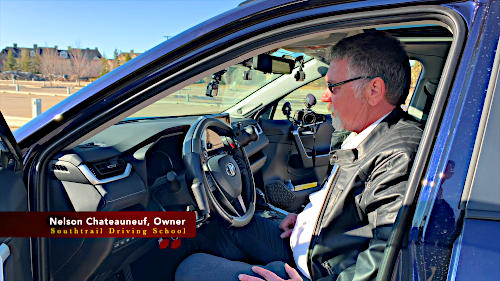
He's the owner of Southtrail Driving School, and he went over all of the options available to drivers with disabilities.
Stick around.
We'll be right back with that information.
Nelson Chateauneuf - Southtrail Driving School
- So, I'll start with the...
It's called the RF360 Mini, where you got all six buttons here for the different functions around your car.
So in order for these to work, I got to start the car.
Same as any other instruments in your car.
You got to start your car for them to get, to work.
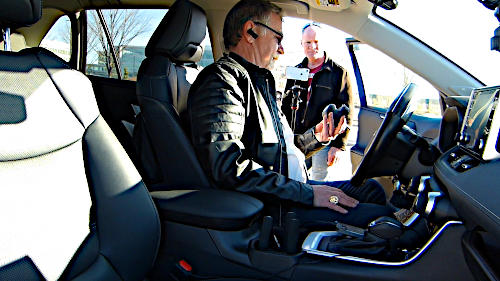
So here we go.
We got our regular signal, right.
Regular signal, left.
Secondary Controls for the Vehicle Right On the Spinner Know
Now I'm going to do it with the 360 Mini, RF 360.
Here we go.
Signal left and I push it on again, to cancel.
And it cancels by itself after 15 seconds.
And at a light, you're stopped at a light, you got it on.
As long as you got your foot on the brake or your hand on the brake, the signal light stays on.
 Okay, so, I'm going to cancel signal light.
Okay, so, I'm going to cancel signal light.
Here's my horn.
Here's the wipers.
Okay, and you've got to click on it four times to turn it off.
Here's low beams, high beams.
Okay.
And again, here, the right hand signal, turn it off.
And my windshield washer is on this button here.
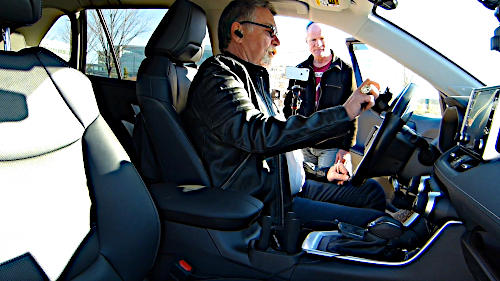
So this the newest of Sure Grip technology here for hand controls.
And then you can have it on the right side or you can set it on the left side.
It's, so this way here, you don't let go of your steering wheel.
The other one like this, if you don't like the buttons sticking out like that, you, we've got the RF-360.
And again, it's made by Sure Grip.
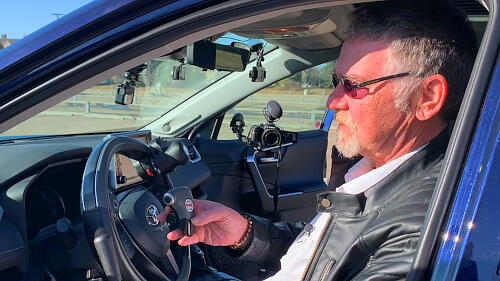
It's a Canadian company.
Well-known from New Brunswick and they got the buttons flush and it's a different kind of a handle.
We also got the Tri-Pin, for, So here we go.
So you keep, and it could tighten up.
So you got the Tri-Pin, comes in pretty handy.
It's being used, but again they have to let go to go honk their horn.
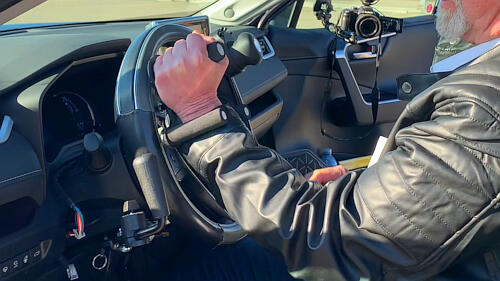
So now I'd like to introduce the hand control part of it.
So I turned the car off.
Now I'm going to start the car.
Okay the car's running.
And in order to activate the hand control, I got to push a button here.
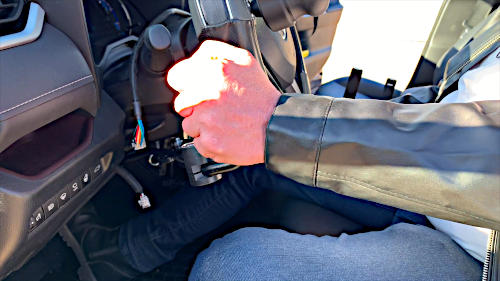
Hand Control to Operarte the Gas & the Brake
So that's again, safety because you don't want your mechanic just to be running your car with the system.
There's our gas.
There's our brake.
So it's push in, rock, angle.
It's called the push-in rock angle.
Left and right.
So there you are.
You can cruise all day.

Work your way to Vancouver or Halifax.
And you'll be just as safe as any other driver.
There's no reason why a person with a physical disability can not drive.
So I encourage anybody, everybody, that needs this kind of system to do it.
Left Gas Pedal
Okay, now I'm going to show you another system now.
It's called your Light Feather gas pedal.
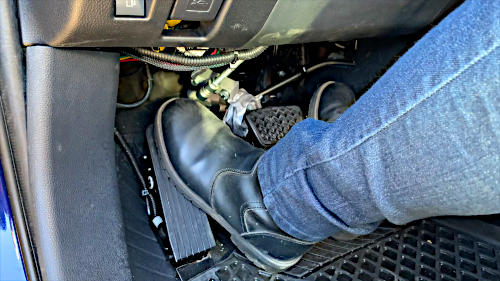
- So this would be for amputees who don't have the right leg they would able, to be able to drive with their left leg?
- Correct.
- [Rick] Okay.
- So amputees or people that's had a stroke, paralyzed on the right side, now they can drive on, everything on the left side.
Working in the Parking Lot to Get Accustomed to the Hand Controls
So here we go.
So now we got the left gas pedal and we got our spinner knob with the six functions on it.

So here we are going with Rick testing, this new hand control.
I got my seatbelt on and I'm holding on.
- I just don't, want to go out that way?
- Just drive around the lot here, Rick.
And then we'll go out on the streets just slowing down on your corner.
I like to say to the students at 15 to 18 kilometers an hour-
- [Rick] Yeah.
- you'll never go wrong.
The car's not going to pull.
- Yeah, so it's interesting because it's just this, just twists and then to brake, the whole assembly moves forward.
- [Nelson] Correct.
- [Rick] Yeah.
You're right, it is.
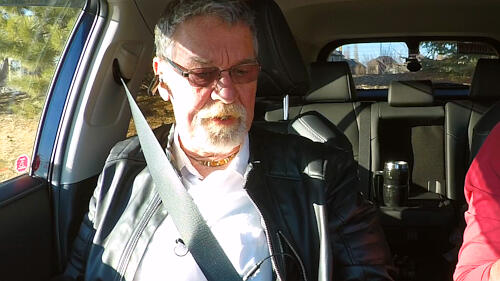
The whole thing is like the brake and everything, is sensitive.
- People get used to it, you know? It's-
- [Rick] Yeah.
- [Nelson] It's like, you're getting a new cell phone.
How long does it take you to get used to it? You know, some people will take three months to get used to it.
This system here, they get used to it, like within a couple hours.
- Well, and it's very intuitive too, right? Like we're moving forward.
All your momentum is going forward when you're braking.

So you're already moving forward, so it's helping you to brake, right?
- Sure.
And then when you pull back, it's, you know, it's not something that you're going to mistake when you're driving.
Now, the only thing, like you said pre- before is the risk is to resist taking your hand off the wheel.
- Yeah.
So that was what the old Spinner Knob System.
As this one here, you don't need to take your hands off the steering wheel, so-
- [Rick] Yep.
And then the other thing- that I want to work on is, and then signal, slow down, and then around and then I can cancel it, or it will cancel on its own, as you said.
- Correct.
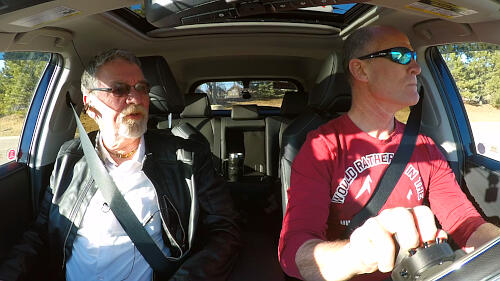
- [Rick] Cool! Very cool.
- As if you're using the regular Spinner Knob, you're going to be taking your hands off the steering wheel, or the Spinner Knob-
- Yeah.
- to go signal, honk your horn, use your wipers, which is highly unsafe.
I mean, it takes 3/4 seconds-
- [Rick] Yeah.
- to get into a collision, real quick, and, it distracts also your, you know, the old system, your reaction time.
So it's going to take you longer to react with the old system.
- [Rick] Yeah.
- [Nelson] As this one here, it's right away.
- I have to say I'm a huge advocate of backup-
- Backup, yeah - up cameras.
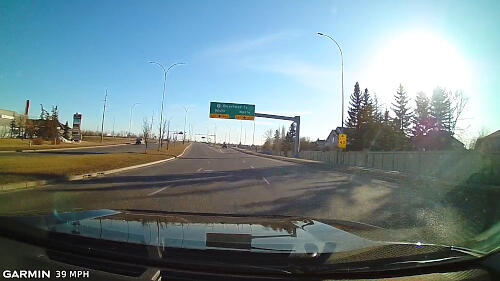
- So here, of course, you know, to put it in gear, you got to put your hand on the brake.
- Yeah.
- So it's safe to change gears then.
- Yeah.
- Now the only thing, it's an automatic transmission, obviously.
Electronic Parking Brakes - apply the parking brake every time
I advocate putting on the parking brake.
The only thing is is that this vehicle would be a foot control for the parking brake, right?
- So, no.
This one here has the automatic-
- [Rick] Electronic.
- Yeah.
If you've got the foot one, then there's a call, what they call the brake extension.
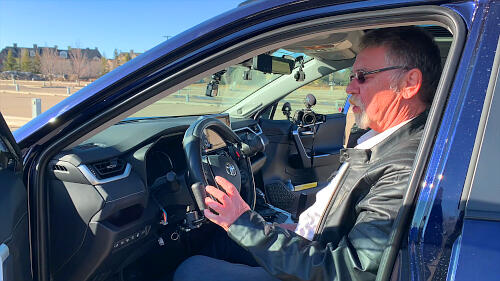
- Okay.
- So it's a little piece of rod coming out that hangs on to the-
- Okay.
brake and, they push it down.
- I'm still getting used to these newer cars having these electronic parking brakes.
- Well, I still show the kids, you know, before their road tests on, during their lessons to put it on-
- [Rick] Yeah.
- [Nelson] Even though it comes on automatically, because I want them to get used to it.
- Yeah.
I'll try to stay out of the puddles in your nice clean car.
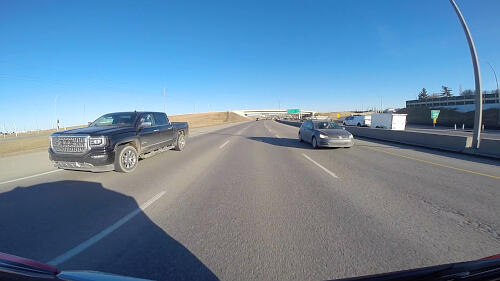
- [Nelson] I wouldn't worry about it.
I wash it every day.
- All right, let's go for a drive.
- All right.
Rick is, feel pretty confident here with this new system.
When I was training in Toronto, Rick, so I was on the 401 with my instructor over there while I was training.
And now always tempted with my right foot, to push the brake pedal.
- Actually, you know-
- Yeah?
- Now that you say that, I have my foot-
- Your foot on- over the brake pedal.

- And what my instructor says, he's watching me.
He says, "You do that one more time, I'll tie your foot to the seat."
Driving in Residential Areas with Hand Controls
- And I'll give you lots of warning.
It's always straight unless we ask, Mr. Student.
So let's see how Rick does here with signaling.
- Oh, this first left.
So he signals left, shoulder check to his left.
Make sure no Pokemons are there.
Starting May 31st, where there's no yellow lines-
- [Rick] Okay.
- [Nelson] Speed zones will be 40 kilometers.
- [Rick] Oh, interesting.
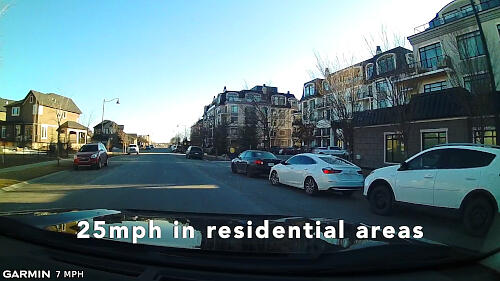
- [Nelson] Yeah.
- But we're in a park zone right now, 'cause that sign back there said it was a playground.
So, and playground here.
-And a playground here.
- [Rick] Yeah, so right here.
- I'm just not used to instruct a pro.
So here we could take Deerfoot south, so you'll have to change lanes.
So Rick- - [Rick] Oh yeah.
- [Nelson] is going to signal, another mirror, mirror, shoulder check.
I watch a lot of his videos so I got a pretty good idea of how he does it.
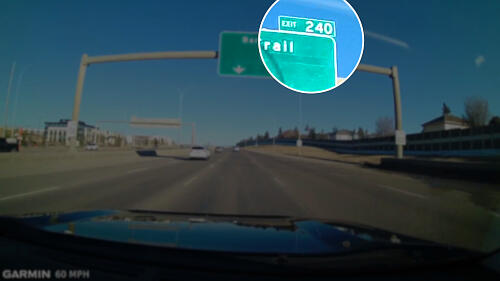
What the Heck are Mile Markers?
All right, Rick.
So you see on top of Barlowe Trail, the sign that says exit 240?
- Yep, the mile marker?
- You got me already.
All right, you got it.
Most people don't know this.
Kids, you know I'm, I tell them we're 240 kilometers from the border.
- [Rick] Yep, okay.
So, is zero the border, then?

- [Nelson] Zero would be the border.
- [Rick] Okay.
Government Assistance for Driver's with Disabilities
- So with 1% of the population being physically disabled, apparently 75% of that 1% is on the Age Program where they receive some government aid.
How about if we pull over Rick and use the left gas pedal now.
Yeah, I'm so glad I got into this part of the business, of driver education.

- [Rick] Yeah.
- [Nelson] Working with, disabled, physically disabled people.
- Yeah.
- They seem like they really enjoy it.
They really appreciate it, and that- Wrong pedal, Rick?
- Yeah.
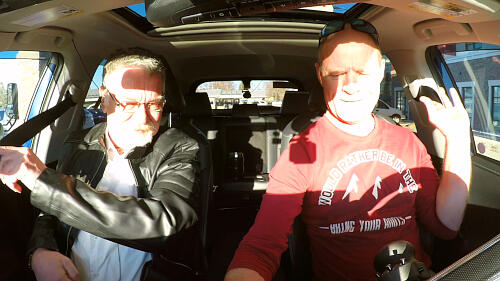
- Wrong pedal.
Okay, like I said, it would take me a couple of days to-
- Power off-

